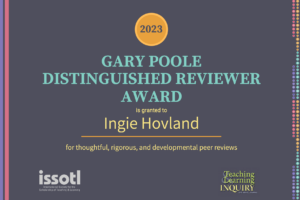
Learning Design Reconsidered with AI Educational Companionship
By Chwen Jen CHEN (cjchen@unimas.my) & Chee Siong TEH (csteh@unimas.my), Universiti Malaysia Sarawak
With the emergence of generative AI chatbots, a new wave of technological disruption is revolutionizing education. Generative AI chatbots are gaining rapid popularity in education due to their ability to generate text, answer queries, translate between languages, summarize lengthy texts, and more. ChatGPT is a well-known example of this technology, but many other alternatives are available. These chatbots use conversational interfaces to interact with users in natural language and generate fluent, grammatically correct, and contextually relevant responses. By acting as cognitive companions, they can help extend humans’ limited memory and reasoning capacity for cognitive tasks, such as thinking, problem-solving, and learning.
Generative AI chatbots can assist educators in several ways, including creating learning resources, tutoring, generating various assessment items, and supporting the Scholarship of Teaching and Learning. They can also aid students in obtaining information, explanation, and resources on various subjects, providing practice exercises, and offering writing and grammar feedback. The tool enables text to be translated between languages, making it simpler for students to access and comprehend content written in a foreign language.
The tool also can enrich students’ creativity by generating ideas and resources that students can further brainstorm, consider, and refine to produce relevant solutions to problems in various fields. Besides, the tool can support and guide students’ research process. However, it is essential to remind students of the ethical concerns of using such a tool and provide them with AI literacy.
As educators and learning designers integrate this tool into teaching and learning, it prompts the need to reconsider the four crucial elements of learning design: learning outcomes, learning resources, learning activities, and learning assessments.
Learning Outcomes: Regarding learning outcomes, the AI tool serves as a superb human memory extension and interactive explainer. Educators must reconsider learning outcomes focusing on the lowest thinking order levels of the Taxonomy Bloom, remembering and understanding. If it is not crucial to gauge students’ ability to regurgitate knowledge without the assistance of non-human resources, related learning outcomes of this level should be removed. Similarly, in many cases, students’ ability to employ their understanding of specific subject matters in higher-order thinking tasks will form more relevant learning outcomes. Educators may, however, consider including learning outcomes emphasizing students’ ability to construct their understanding or knowledge through effective interaction with the tool. Appropriate utilization of this tool’s reasoning and reckoning abilities provides astonishing possibilities and assistance for students to form more comprehensive and superior higher-order thinking learning outcomes. Hence, integrating this tool will emphasise higher-order thinking learning outcomes, which include applying, analyzing, evaluating, and creating skills.
Learning Resources: This tool can significantly assist educators in proposing and creating various learning resources, which include learning and assessment materials. Educators can also use the tool-generated content to verify the accuracy and currency of their existing materials. Moreover, it can suggest learning activities and, in some cases, participate in them as a learning companion for students. As for students, this tool affords them to create their required and preferred learning content by conversing with their new, non-human personal tutor.
Learning Activities: This tool’s unique affordances spur educators to reconsider the appropriate learning activities, as some existing learning activities may now become irrelevant. On the bright side, such a tool creates more possibilities for implementing activities that can produce meaningful learning that often emphasizes knowledge construction, conversation, collaboration, reflection, and innovative, creative outcomes for higher-order thinking tasks. Some feasible learning activities include requesting students to report on how knowledge is constructed individually through personal conversation with the tool; answer or solve practice problems generated by the tool to reinforce learning; brainstorm, consider, and refine ideas generated by the tool in group projects; apply constructed knowledge in solving local, real-life contexts or complex problems; articulate the constructed knowledge in a live class session; express the constructed knowledge in visual forms such as mind maps, illustrations, and sketches; synthesize ideas to produce a better product or system; verify information derived from the tool; reflect on the connection between tool-generated content with course content or personal experiences, and debate with the tool on a chosen issue to assist students in constructing multiple perspectives towards the issue.
The choice of specific activities depends on the course content and desired learning outcomes. With the integration of this tool, educators’ tutoring role is now replaced by a dedicated, high cognitive power AI companion. Hence, their new roles focus on facilitating students on the effective adoption of AI-powered tutors, supervising students’ personalized lower-order knowledge construction, and facilitating students in higher-order learning tasks for meaningful learning. On the other hand, students’ roles focus on crafting personal learning paths to augment knowledge gained from the teacher and connecting human and non-human resources for meaningful learning to produce innovative, creative outcomes for higher-order thinking tasks.
Learning Assessments: The incorporation of AI chatbots also demands the reconsideration of appropriate learning assessments. Educators must align these assessments with the determined learning outcomes and give additional attention to process-oriented learning assessments besides product-oriented assessments. Process-oriented assessments may include assessing students’ ability to express constructed knowledge in a visual form; reason by examining their prompting quality; evaluate or judge the authenticity of tool-generated content; analyze and decide on relevant tool-generated content; reflect on the relevancy of constructed knowledge; and collect and connect ideas from various resources. Product-oriented assessments may include synthesizing ideas from various resources to form a meaningful whole; solving local, real-life contexts or complex problems; developing systems or products; and producing innovative, creative solutions.
In conclusion, integrating AI as an educational companion into learning design has vast potential to transform how we approach teaching and learning. By rethinking learning outcomes, resources, activities, and assessments, educators can harness the full potential of this tool and provide students with more opportunities for meaningful learning that emphasize knowledge construction, higher-order thinking, and creative outcomes.





